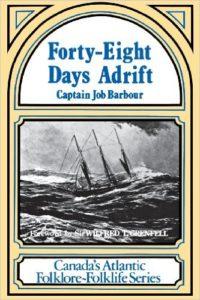History
Forty-Eight Days Adrift
Story of Captain Job Barbour: who survived an unplanned Atlantic adventure
Captain Job Barbour was born in Newtown in 1898. He began sailing as a boy and at the age of twenty-one he first became master of a vessel. For many years he sailed the treacherous waters off Newfoundland’s Northeast coast, carrying provisions from St. John’s to the outports. In 1929, while on one of these voyages in his three masted schooner, Neptune II, he was driven off course by several storms – way off course. He was about to cross the Atlantic Ocean.
These days, when nearly everyone owns a smartphone with built in google map support, and has a GPS in their car, the reaction when the signal drops is often one of panic and the thoughts of many a person began to wonder “Am I Lost? Is it this turn on the left or the one on the right that I supposed to take?”
Truth be told, it is hard for us to imagine being totally lost in this day and age for but a few minutes. It is nearly downright impossible for us to imagine what it must be like to be adrift on the Atlantic Ocean for 48 days. This very thing happened in 1929, when Captain Job Barbour and the crew and passengers of the Neptune II left St. John’s, Newfoundland for a return trip to their home port of Newtown, Bonavista Bay.
The Neptune II, a three masted schooner, had brought a load consisting mainly of salt cod and cod oil to St. John’s and began their return journey on November 29th with cargo that included apples, oranges, and raisins for the store in Newtown. The 100 mile journey should have taken a few days but the next morning had other plans. On November 30th, the winds had reached hurricane strength and began what would be an arduous journey that lasted 48 days.
During this time, the high winds and rough seas battered the schooner and left, among other things, crew members injured, passenger Mrs. Humphries incredibly ill and conversations held with what will be done if she passed away while at sea, water casks tainted with salt water leaving it unfit for drinking, unable to reach the supplies lashed in the hull, the wheelhouse washed overboard, the only boats destroyed, the binnacle smashed to pieces, and the compass light was out. As noted, these were just SOME of the issues that the crew faced but as Captain Barbour once said.
“Newfoundland seamen are noted for their ingenuity and when the real thing is gone or won’t work they try to make something that will do”.
It was this ingenuity, coupled with their resilience and bravery that allowed the Neptune II to remain afloat and found them drifting towards Tobermory, Scotland on January 16th, 1930. The Hesperus, a steamer, attached a towing line and guided the battered vessel into Scotland where Captain Barbour was finally able to send a telegram to his mother stating
“Arrived Safely Tobermory, Scotland. All well. Job K. Barbour”.
The Book

Just as his brother, Lester, had provided a written record of his World War I experience, Captain Job Barbour also committed his story to paper. In 1932, “Forty-Eight Days Adrift,” was published in London, England. Many years later, Newfoundland’s-own Breakwater Books revived the story and published it in 1981 as part of its Canada’s Atlantic Folklore/Folklife Series. Breakwater was able to include a foreword by Sir Wilfred Grenfell that was intended for the 1932 edition, but it was not used at that time. Breakwater released a second edition in 1983 and a reprinting in 2001. “Forty-Eight Days Adrift” remains a very popular book at our gift shop and has been dramatized in our theatre which is named Neptune II after Captain Barbour’s ship. The Book is also available on Amazon.
Interview Excerpts
In 1979 CBC interviewed Captain Barbour who was then 81 years old. He retold parts of the story in that interview. (CBC archival issue)
“Like living demons hungry for our lives the seas rushed over our bulwarks and swept the deck fore and aft. They fascinated you almost as they approached. The water seemed to be all colours of the rainbow when coming on in its mad and crested cumulus. I never thought till then that seas could run so high. They looked like huge icebergs that had suddenly been liquefied and driven by some demon of the sea to rush on and crush us to death.”
“…after some of the big seas swept in, they would act as if searching for us, seeing there was no one on deck. They would gush into the forecastle, ignoring doors and barriers and, not satisfied with flooding the floor knee-deep and drenching the crew, would rush on as if seeking our lady passenger.”
“…I could see the look of anguish that covered Mrs. Humphries’ face. No doubt she thought that it would be her last moment of life. She then would say, “Are we sinking?” and someone would reply “No, Mrs. Humphries, nothing can sink this vessel.” We thought it best to cheer her up in this way, though we were all full of doubt.”
